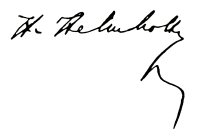Our Patron Hermann von Helmholtz
Hermann von Helmholtz was one of the last universal scholars. He reflected a natural science which spanned the fields of medicine, physics, and chemistry. His groundbreaking research work and developments combined theory, experiments, and practical applications.
- Hermann von Helmholtz was born in Potsdam on August 31, 1821
- In 1838, he started his studies in medicine at the Berlin Military Academy
- He was awarded the title Doctor of Medicine in 1842
- Starting in 1846, he was a military doctor in a royal regiment
- Between 1849 and 1855: Professor of Physiology and Pathology in Königsberg
- From 1871: Professor for Physics at the Friedrich Wilhelms University Berlin, today’s Humboldt University
- From 1882, he was one of the initiators, in addition to Wilhelm Foerster and Werner von Siemens, of the subsequently founded Physikalisch-Technische Reichsanstalt [Physical Technical Institute of the German Empire] (today’s Physikalisch-Technische Bundesanstalt) [Federal Physical Technical Institute].
- In 1888, he became the first president of the Physikalisch-Technische Reichsanstalt in Charlottenburg
- Hermann von Helmholtz died in Berlin Charlottenburg on September 8, 1894
 Research and Development
Research and Development
Helmholtz conducted research in medicine, physics, mathematics, psychology, music, and philosophy. His research findings which had a lasting impact in the world of science include, for example, his formulation of the law “On the Conservation of Energy.” His research on hydrodynamics and on the theory of electrodynamics set the course for later generations of scientists. And it was Helmholtz who mathematically formulated the first main theorem of thermodynamics.
Helmholtz is also considered to be the founding father of modern meteorology with his mathematical studies of such natural phenomena as cyclones, thunderstorms, air and water waves as well as glaciers.
Ophthalmologists and their patients are indebted to Helmholtz for the ophthalmoscope which allowed him to make the retina become visible for the very first time. He also developed the ophthalmometer, an instrument for measuring the corneal curvature.
 The Helmholtz Association
The Helmholtz Association
The Helmholtz Association of German Research Centres was created in 1995 to formalize existing relationships between several globally-renowned independent research centers. The Helmholtz Association distributes core funding from the German Federal Ministry of Education and Research (BMBF) to its, now, 18 autonomous research centers and evaluates their effectiveness against highest international standards.
Link to the history of the Helmholtz Association
Once a year, the Helmholtz school labs organize a nationwide Helmholtz Day.


